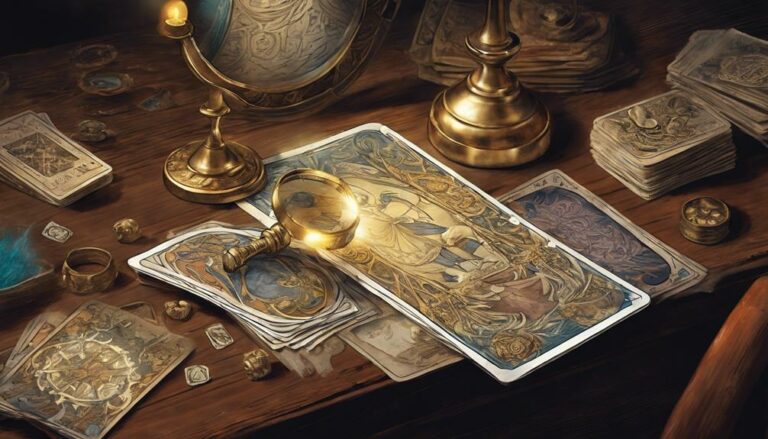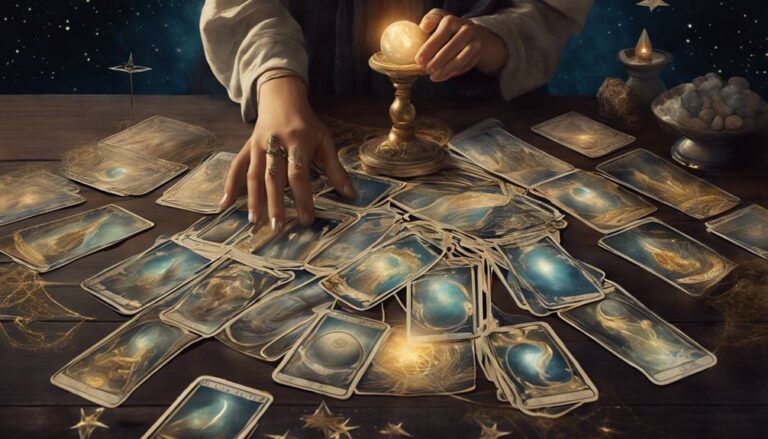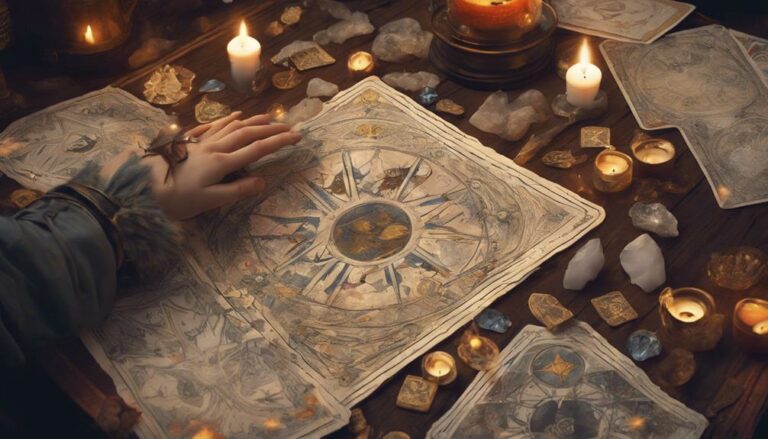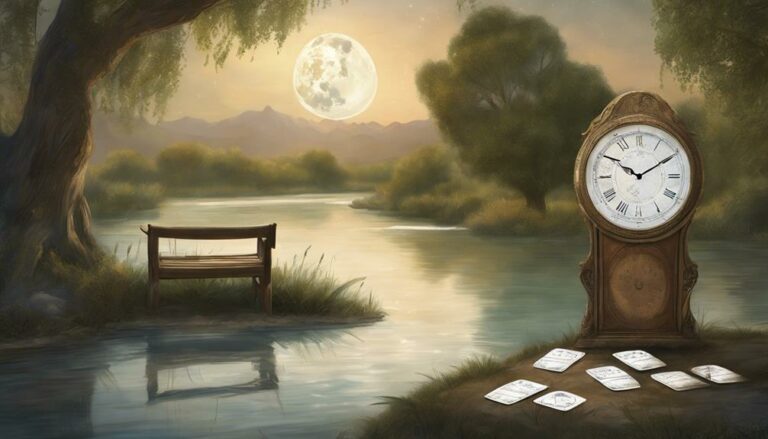Tarot cards have always fascinated me. Their enigmatic allure, intricate designs, and mystical interpretations have intrigued seekers and enthusiasts for centuries. In this article, we’re embarking on a journey to uncover the origins and evolution of tarot cards. Join me as we explore the historical roots, delve into the symbolism, and navigate through the changing landscapes of tarot’s significance.
Table of Contents
ToggleIntroduction
Tarot cards have a timeless allure that draws people into their world, inviting them to explore the depths of the unknown and unravel the mysteries of life. As an ardent enthusiast and advisor in the realm of tarot cards, I have personally experienced the transformative power these cards hold. This article is a journey, a journey into the origins and evolution of tarot cards – a journey that I am excited to embark on with you.
In a world filled with uncertainties and questions, tarot cards stand as unique companions that offer both guidance and introspection. Their intricate symbols, vivid imagery, and age-old wisdom have captured the imagination of seekers and enthusiasts for generations. From ancient civilizations seeking answers from the cosmos to modern individuals seeking insights into their own lives, tarot cards have transcended time, cultures, and beliefs, leaving an indelible mark on the tapestry of human experience.
In the pages ahead, we will delve into the fascinating history that gave birth to these mystical cards. We will explore how tarot cards emerged from the playful realms of card games to become a conduit for divination, reflection, and personal growth. This journey isn’t just about history; it’s about understanding the profound impact that these cards have had on individuals, societies, and even the way we perceive ourselves and the world around us.
As we navigate through the chapters of this article, I will share insights, anecdotes, and suggestions that stem from my own passion for tarot cards. Whether you’re a seasoned tarot reader, a curious beginner, or someone simply intrigued by the allure of the unknown, there’s something here for you. We’ll unravel the threads that connect the ancient roots of tarot to its modern interpretations, exploring the shifts in its purpose, symbolism, and significance.
So, dear reader, join me on this enchanting expedition into the heart of tarot’s origins and evolution. Let’s unravel the secrets woven into each card, uncover the stories they tell, and embrace the transformative journey that these cards offer. As we peel back the layers of time, let us not only gain a deeper understanding of tarot but also forge a stronger connection with ourselves and the mysteries that lie within.

Ancient Roots of Divination
In the shadowy corridors of antiquity, where the stars whispered secrets and nature held its mysteries, humans sought to connect with the unseen forces that governed their lives. The ancient roots of divination, woven into the fabric of early civilizations, laid the foundation for the intriguing journey that would lead to the emergence of tarot cards.
Long before the concept of tarot took shape, divination was a practice intertwined with the very essence of existence. Early societies, marveled by the grandeur of the cosmos, looked to the heavens for guidance. They read omens in the flight of birds, interpreted dreams as messages from the divine, and cast lots to peer into the unfolding tapestry of fate.
Playing cards, the precursors to tarot, appeared on this stage of mystical exploration in a seemingly innocuous form. While today we associate them with games of chance and strategy, they held a deeper significance for those attuned to the whispers of the universe. These humble cards, with their suits and symbols, became tools for deciphering the threads of destiny.
In cultures as diverse as ancient China, Egypt, and Persia, the art of divination was a bridge between the human realm and the ethereal. Priests, seers, and scholars deciphered the language of symbols, interpreting patterns and messages from realms unseen. They understood that the ordinary was a mere veil, and that beneath it lay the extraordinary – insights into the heart of existence itself.
The practice of divination was a way to seek solace in uncertain times, to grasp a thread of meaning in the midst of chaos. It was a testament to humanity’s unyielding curiosity and our innate desire to find purpose in the mysterious dance of life. In this rich tapestry of ancient divination, playing cards found their niche – a prelude to the captivating world of tarot.
As we journey deeper into the history of tarot, we uncover the threads that connect the dots between these ancient practices and the modern interpretations of the cards. Tarot’s emergence may have been centuries away, but its roots stretch back through time, intertwining with the very essence of human curiosity and our ceaseless quest for understanding.

Emergence of Tarot in the 15th Century
The 15th century marked a pivotal turning point in history, a period when the Renaissance was in full bloom, art flourished, and the thirst for knowledge drove societies to explore new horizons. It was within this vibrant backdrop that the seeds of tarot were sown, eventually giving birth to a fascinating and enduring phenomenon.
In the midst of this cultural renaissance, as Italy became a melting pot of creativity and innovation, the emergence of tarot cards was a quiet yet significant event. What began as a simple deck of playing cards gradually metamorphosed into a powerful tool for divination and self-discovery. But how did these unassuming cards make this transition?
The transformation began with the infusion of symbolic depth into the traditional playing card deck. This marked the first whisper of the profound journey that tarot was destined to embark upon. The earliest tarot decks, such as the Visconti-Sforza tarot deck, were adorned with intricate illustrations that depicted allegorical figures, celestial symbols, and archetypal scenes. These cards hinted at a realm beyond the mundane, inviting those who held them to explore the mysteries of the universe.
The evolution of tarot was facilitated by the convergence of various cultural, artistic, and spiritual currents. As the cards transitioned from mere game pieces to windows into the cosmic unknown, they found themselves embraced by scholars, philosophers, and mystics of the time. The intricate symbolism of the cards echoed the allegorical artwork that permeated Renaissance culture – a language that transcended words and reached directly into the realm of the soul.
One notable aspect of this transformation was the shift in purpose. Tarot cards, once used for games of chance, began to be viewed as vessels of divination, offering insights into the past, present, and future. The spread of tarot throughout Europe and its incorporation into esoteric practices opened a door to a world of possibility. The cards themselves became keys to unlocking the hidden truths of existence.
As we delve into the history of tarot, it’s important to recognize this pivotal period – the 15th century – as a juncture that laid the foundation for the intricate web of symbolism, wisdom, and mystique that tarot cards have become known for. The emergence of tarot in this era was a testament to humanity’s yearning for connection, understanding, and meaning. It was a precursor to a journey that would transcend time and culture, guiding individuals through the twists and turns of their lives, while echoing the whispers of ages long past.
Early Tarot Decks and Symbolism
In the dimly lit corners of history, a tapestry of symbolism was woven into the fabric of tarot decks, creating a visual language that spoke to the very depths of human consciousness. The early tarot decks, such as the illustrious Visconti-Sforza deck, emerged as intricate works of art and divination, each card a portal to a world of meaning beyond the surface.
The Visconti-Sforza tarot deck, created in the 15th century, stands as a testament to the intricate fusion of symbolism and artistic expression. The Major Arcana, a collection of 22 cards, bore allegorical figures that spanned the range of human experiences – from the innocent wonder of The Fool to the transcendence of The World. Each card held a mirror to the complexity of life, encapsulating virtues, vices, and archetypal forces that resonated across cultures and time.
The Minor Arcana, a complement to the Major Arcana, consisted of four suits – swords, wands, cups, and coins. These suits, predecessors to the modern hearts, clubs, diamonds, and spades, carried their own distinct symbolism. Swords embodied intellectual and emotional challenges, wands symbolized inspiration and growth, cups represented emotions and relationships, and coins signified the material and physical realms.
It’s within the Minor Arcana that we find the roots of the playing card suits we recognize today, demonstrating the seamless transition from a playful game to a profound tool for exploration. The court cards – pages, knights, queens, and kings – added depth to the narrative, depicting characters that embodied qualities of personality, action, emotion, and intellect.
The symbolic language of the tarot allowed for a multiplicity of interpretations, inviting readers to delve beyond the surface and uncover layers of meaning. The cards themselves were a canvas on which seekers projected their own stories and struggles, finding resonance in the timeless themes they portrayed.
The early tarot decks served not only as a medium for divination but also as a reflection of the era’s cultural values and beliefs. The symbolism drawn from various traditions, such as Christian iconography and ancient mysticism, converged to create a unique tapestry of wisdom. These decks were an open door to the psyche, beckoning individuals to explore the recesses of their own minds and souls.
As we study the early tarot decks and their symbolism, we uncover a lineage that stretches from ancient civilizations to modern interpretations. The threads woven by the early artists and mystics have been picked up by subsequent generations, who continue to infuse the cards with new layers of meaning and insight. The symbolism of these early decks transcends time, bridging the gap between centuries and offering us a profound glimpse into the eternal dance of human experience.

Tarot’s Influence on Occultism
In the hushed corners of esoteric circles, tarot cards emerged as more than mere divination tools – they became gateways to the mysteries of the universe, connecting seekers to the realms of the unseen. The marriage of tarot and occultism was a union of symbolism and intuition, forging a path into the enigmatic and the unexplained.
As the currents of the occult surged through the 19th and 20th centuries, tarot cards took center stage, resonating with those who sought to explore the hidden dimensions of existence. Occultists recognized the potent language of symbolism woven into each card – a language that transcended language itself, speaking to the innermost chambers of the soul.
Tarot’s influence on occultism was a convergence of ancient wisdom, mystical traditions, and the quest for enlightenment. The cards, especially the Major Arcana, became a mirror reflecting the journey of the soul, with each card embodying an archetype that encapsulated the human experience. From the introspective depths of The Hermit to the transformational energies of Death and rebirth, these archetypes were windows into the labyrinthine corridors of consciousness.
One of the most notable figures in the marriage of tarot and occultism was French occultist Éliphas Lévi. Lévi’s work drew upon the symbolism of the tarot to illustrate his ideas about the nature of the cosmos and the spiritual realms. He recognized the cards as a mirror reflecting the macrocosm and microcosm, a tool for understanding the interplay between the celestial and earthly realms.
Tarot’s influence also extended to the Hermetic Order of the Golden Dawn, a secret society that embraced a holistic approach to spiritual exploration. Members such as Arthur Edward Waite and Aleister Crowley, both prominent occultists, made significant contributions to tarot interpretation. Waite’s collaboration with artist Pamela Colman Smith resulted in the iconic Rider-Waite tarot deck, known for its evocative imagery and deep symbolism.
Crowley, on the other hand, infused his unique perspective into the Thoth tarot deck. His deck delved into the layers of mysticism and alchemical transformation, inviting seekers to explore the intersection of magic, psychology, and spirituality.
Tarot’s influence on occultism wasn’t confined to individuals or secret societies. The cards began to be seen as mirrors of the soul, portals to the collective unconscious, and tools for tapping into higher consciousness. Tarot readings transformed into rituals, each draw of the cards a communion with the mysteries that danced on the edges of perception.
In essence, the union of tarot and occultism expanded the cards’ role beyond fortune-telling or even personal growth. They became guides for those who sought to traverse the boundaries between the known and the unknown, to explore the realms where logic and reason gave way to intuition and insight. Tarot’s influence on occultism thus opened doors to a deeper understanding of the human experience, inviting individuals to embark on a journey of discovery that extended far beyond the physical realm.
Rider-Waite Tarot and Its Impact
Amidst the tapestry of tarot’s evolution, one deck stands as a timeless beacon that illuminated new horizons of interpretation – the Rider-Waite tarot deck. Illustrated by Pamela Colman Smith and guided by the insights of Arthur Edward Waite, this deck not only redefined the visual language of tarot but also left an indelible mark on how we perceive and interact with the cards.
The Rider-Waite tarot deck, born in the early 20th century, departed from the prevailing norms of its time. While previous decks contained symbolism and depth, the Rider-Waite deck introduced a new level of evocative imagery that resonated deeply with both tarot enthusiasts and those unfamiliar with the cards. Each card became a window into a world of rich symbolism and narrative.
The impact of the Rider-Waite deck was twofold. First, its imagery brought the archetypal figures of the Major Arcana to life in a way that transcended cultural boundaries. The Empress became a nurturing embodiment of motherhood, the High Priestess exuded the mystique of hidden knowledge, and the Fool embodied the essence of innocence and new beginnings. These depictions spoke to the universal themes of the human experience, making the cards accessible and relatable.
Second, the deck’s symbolism invited seekers to embark on a journey of introspection and self-discovery. The illustrations were not merely static images; they were windows into the psyche. This was particularly evident in the Minor Arcana, where the pip cards – numbered cards – were adorned with scenes that captured the essence of their respective suits. For example, the Five of Cups depicted a figure in mourning, a poignant representation of loss and emotional turmoil.
The Rider-Waite deck also introduced a unique addition – pictorial scenes on all 56 cards of the Minor Arcana. This departure from tradition provided a wealth of visual cues for interpretation, making the cards accessible even to those new to tarot. Additionally, the court cards – Pages, Knights, Queens, and Kings – were infused with personalities, making them relatable and dynamic figures in the tarot narrative.
Beyond its visual impact, the Rider-Waite tarot deck set a precedent for tarot interpretation. Arthur Edward Waite’s accompanying guidebook, “The Pictorial Key to the Tarot,” provided comprehensive insights into the meanings of the cards. This guidebook encouraged readers to explore not only the surface symbolism but also the layers of depth that each card held. The deck’s symbolism and Waite’s interpretations laid the groundwork for the modern approach to tarot reading.
The Rider-Waite tarot deck’s influence reverberates through the tarot landscape to this day. Its enduring legacy lies in its ability to speak to the human experience, offering a language of symbols that transcends time and culture. As we delve into the world of tarot, the Rider-Waite deck remains a touchstone – a reminder that each card is an invitation to explore the profound realms of the psyche, and that the stories they tell are echoes of our own journey through life.
Psychological Interpretations of Tarot
In the tapestry of tarot’s evolution, a profound transformation occurred that forever changed the way we engage with the cards – the shift from divination to psychological interpretation. This evolution was a result of the merging of tarot with the realms of psychology and introspection, guided by the insights of luminaries like Carl Jung and other modern thinkers.
The journey into psychological interpretations of tarot began with the realization that these cards are not just external tools for fortune-telling, but mirrors that reflect the inner landscape of the human psyche. The archetypes woven into the fabric of tarot cards became doorways to understanding the layers of the self, inviting seekers to embark on a journey of self-discovery and growth.
At the forefront of this evolution was Swiss psychiatrist Carl Jung. His concept of the collective unconscious and archetypes provided a framework that resonated deeply with the symbolism of tarot. Jung saw the archetypes in the cards as universal symbols that tap into the deep well of human experience. Each card, he believed, represented facets of the human psyche that are shared across cultures and generations.
For instance, the journey of The Fool, who steps into the unknown with unwavering trust, resonates with the human capacity for new beginnings and leaps of faith. The introspection called for by The Hermit mirrors the need for solitude and inner reflection. The Death card, often misunderstood as a harbinger of doom, symbolizes profound transformation and rebirth.
Jung’s ideas gave rise to a psychological approach to tarot reading. Instead of predicting external events, tarot became a tool for understanding the inner workings of the mind. Reading the cards became a dialogue with the unconscious, a way to bring hidden thoughts, fears, and desires into the light of conscious awareness.
This perspective was further developed by modern psychologists and therapists who recognized tarot’s potential as a therapeutic tool. Tarot cards, when used in a therapeutic context, acted as catalysts for discussion, introspection, and healing. The act of selecting and interpreting cards provided a structured yet flexible medium for exploring one’s feelings, thoughts, and experiences.
In this psychological interpretation of tarot, the role of the reader shifted from fortune-teller to guide, from predicting the future to facilitating self-discovery. Each card became a point of reflection, prompting questions such as: What does this card symbolize to me? How does it resonate with my current experiences? What emotions does it evoke?
As we explore the psychological interpretations of tarot, we uncover a profound merging of ancient wisdom and modern insights. The cards, once regarded as mystical oracles, have transformed into mirrors that reflect the depths of the human experience. This shift reminds us that tarot is not just a tool for divination, but a key that unlocks the doors to self-awareness, growth, and transformation – a journey that transcends time, culture, and the limitations of the external world.

New Age Revival and Tarot
In the dawning light of the New Age movement, tarot cards found themselves embraced by a generation hungry for spiritual exploration, self-discovery, and alternative perspectives. The revival of interest in tarot during this era wasn’t merely a trend; it was a rekindling of the ancient flame that had burned in the hearts of mystics and seekers for centuries.
The New Age movement, which emerged in the mid-20th century, was characterized by a shift away from traditional religious structures and a hunger for holistic approaches to spirituality. Tarot cards, with their enigmatic symbolism and potential for introspection, aligned perfectly with the New Age ethos of embracing personal empowerment, inner wisdom, and interconnectedness.
During this revival, tarot transcended its role as a mere divination tool and became a companion on a journey of self-exploration. Seekers turned to the cards not just for answers about their future, but for insights into their inner landscapes – a practice that echoed the psychological interpretations championed by Carl Jung.
Tarot decks designed specifically for personal growth and spiritual reflection began to emerge. These decks often included affirmations, keywords, and imagery that spoke to the themes of transformation, healing, and self-awareness. The cards became gateways to deeper insights, guiding individuals through the maze of their emotions, fears, and aspirations.
The New Age revival also embraced the concept of synchronicity – the idea that events and symbols in the external world are connected to our inner experiences. Tarot readings, guided by this belief, were seen as reflections of the energies and themes present in an individual’s life. Each card drawn was a piece of the puzzle, a mirror held up to the seeker’s own journey.
Furthermore, the New Age movement brought tarot out of the shadows and into the mainstream. It became a tool for personal growth seminars, workshops, and self-help literature. Tarot, once relegated to the realms of the esoteric, became a means of accessing ancient wisdom in a contemporary context.
As we look back at the New Age revival and its impact on tarot, we see a continuation of the cards’ role as mirrors of the human experience. They offered a bridge between the old and the new, a vessel that carried the wisdom of ages into a modern world hungry for meaning. Tarot’s resurgence during this era was not just a passing trend; it was a reminder that the human quest for understanding, connection, and growth is timeless – and that the cards themselves remain steadfast companions on this eternal journey.
Conclusion
As our journey through the origins and evolution of tarot cards draws to a close, we find ourselves standing at the crossroads of time, gazing back at the rich tapestry we’ve woven. From the ancient roots of divination, where humanity sought solace in the cosmos, to the emergence of tarot in the 15th century as a conduit for the unseen, and its subsequent influence on occultism and psychology – the story of tarot is one of resilience, transformation, and profound human connection.
Tarot cards have transcended their humble beginnings as playing cards and evolved into vessels of wisdom, each card a chapter in the grand narrative of the human experience. The symbolism, carefully woven by ancient and modern artists alike, invites us to explore the depths of our own consciousness, to seek answers beyond the mundane, and to embark on journeys of self-discovery.
The tarot, a reflection of both the mystical and the psychological, has touched lives across cultures, generations, and belief systems. It has become a tool for those who seek guidance, a mirror for those who seek self-understanding, and a bridge that connects us to the mysteries that dance just beyond our grasp.
As we conclude this exploration, remember that the story of tarot is not static; it continues to unfold. Tarot decks, like the branches of a sprawling tree, have diversified, adapted, and transformed to meet the needs of seekers in various walks of life. Whether through themed decks that resonate with modern sensibilities or through digital readings that adapt to the digital age, tarot remains a living tradition.
So, whether you’re a seasoned tarot reader or someone newly introduced to this world, may you continue to engage with tarot cards not just as pieces of cardboard, but as windows to your own soul. May you find in them a mirror that reflects your hopes, fears, and dreams, and a companion that guides you through life’s twists and turns. Tarot cards are not just a journey into the unknown, but a journey into yourself – an odyssey of introspection, connection, and discovery that echoes across time and beckons you to embark upon your own unique path.
FAQs
Are tarot cards just a form of fortune-telling?
Tarot cards can certainly be used for fortune-telling, but their potential goes much deeper. They offer insights into your psyche, prompting self-reflection and personal growth.
How do I choose the right tarot deck?
Trust your intuition. Pick a deck that resonates with you visually and emotionally. The imagery should speak to your heart and mind.
Can I learn tarot on my own, or do I need a guide?
Learning tarot is a personal journey. While books and online resources are helpful, your connection with the cards is unique. Don’t hesitate to explore on your own.
What’s the significance of reversals in tarot readings?
Reversed cards can add nuance to a reading, suggesting challenges or a need for introspection. They offer a well-rounded perspective on a situation.
Is tarot a form of divination or therapy?
Tarot straddles both realms. It can be used for divination, offering insights into the future, but it’s also a tool for self-discovery and therapeutic exploration.










